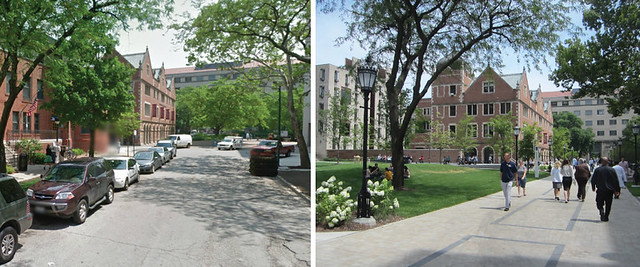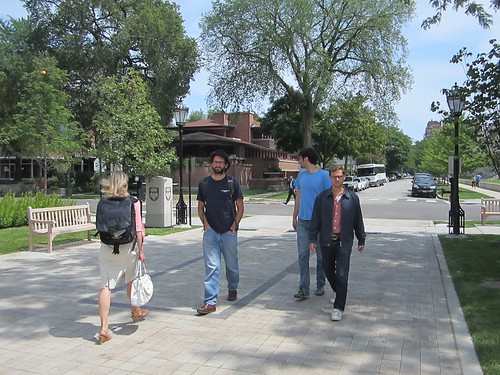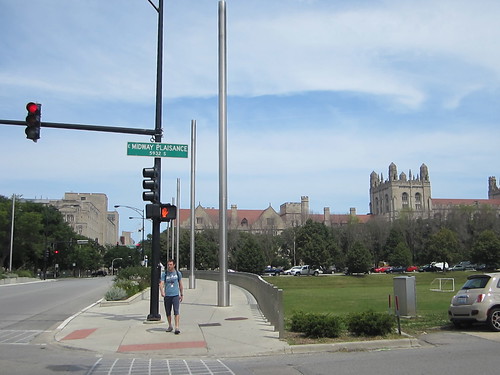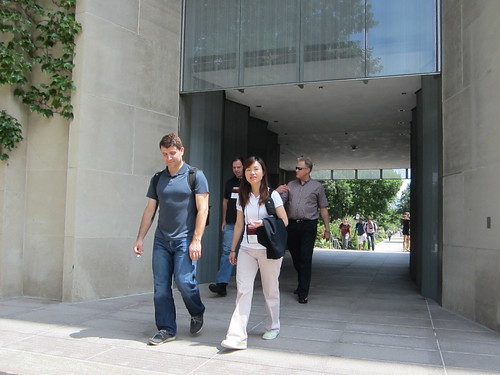[This piece also ran in Checkerboard City, John's column in Newcity magazine, which hits the streets on Wednesday evenings]
I’ve long thought that the gray, Gothic confines of the University of Chicago were designed as a fortress against the outside world. However, in recent years, the school has made an effort to physically open up its grounds to the rest of the Hyde Park community, as well as to connect various parts of the campus that had previously seemed remote, by creating better spaces for pedestrians.
Several construction projects have improved connectivity and made it safer and more pleasant to walk across the 211-acre campus. Meanwhile, sections of roadway have been converted into attractive walkways and plazas, which encourage spontaneous interactions between students, employees and neighborhood folks.
Last year, changes included a new pedestrian space on the west side of campus, by the University of Chicago Hospitals, a new passageway through the administration building, and the completion of the Midway Crossings, bridge-like structures uniting the north and south sides of campus. In June of this year, the university finished converting a block of 58th Street, between University and Woodlawn avenues, into a lively promenade.
“The outdoor spaces on campus can be as important as the indoor spaces,” said university architect Steve Wiesenthal in a statement in spring 2013, before most of the construction started. “These projects will connect parts of campus that have felt distant from each other because of features of our buildings and landscape. They will contribute to our sense of community and the integrated nature of the University.”
A few years ago, the university began building the Midway Crossings, a roughly $8 million streetscaping project, designed to provide better connections between the main campus and buildings south of the Midway Plaisance. Although the Midway, located between 59th and 60th streets, is only one block wide, psychologically the distance felt much longer, especially during the winter, and many people felt unsafe crossing the parkland at night.
To make the trek across the Midway feel shorter and safer, the school created the new walkways along Ellis, Woodlawn and Dorchester avenues. The design was inspired by the green space’s architect, Frederick Law Olmsted, who originally conceived the Midway as a water route between Jackson and Washington parks, traversed by bridges. Workers completed the construction of the crossings in spring 2013.
The Midway Crossings treatments include wider sidewalks, which make it easier for people to travel in groups. Illuminated railings, retaining walls, and lighting masts, dozens of feet tall and affectionately known as the “light sabers” by the students, further increase the sense of security by increasing visibility in general and making it easier to see the faces of other pedestrians.

In the spring of last year, the university announced the three projects to provide an east-west connection across campus. That summer, crews built a new landscaped pathway and public space on 58th west of Ellis, replacing a cul-de-sac. As part of the project, the university demolished Ingleside Hall, which formerly housed the campus post office.
Some Hyde Parkers protested the destruction of the 1896 Georgian building, designed by famed architect Charles Atwood. However, the demolition of the historic building opened up access to the south side of the Crerar science library’s quadrangle, and made space for an extension of the quad, landscaped with small hills. The project also included a new seating area.
It seems like the sacrifice of the historic building may have been worth it. When I visited last week at lunchtime, the area had tons of foot traffic. Dozens of people occupied the lawn, benches, tables and chairs, relaxing, chatting and enjoying lunches from the numerous food trucks parked on Ellis.
Also in summer of 2013, workers created an open-air portal through the university’s imposing administration building, which formerly discouraged entry to the main quad from the west. The new, glass-lined tunnel through the old, gray building looks a little odd, but as you walk east through the gateway, you get a surprising view of the quad’s colorful flowers and other lush plantings. The vista made me feel like Alice, peering through a door into the Queen of Hearts’ garden.
The final link in the east-west connection is the recently completed promenade at the east end of campus, in front of the Oriental Institute museum, and across the street from Frank Lloyd Wright’s iconic Robie House. Although a traffic study predicted that banning cars from the low-traffic block would have little impact on the street grid, the project involved the elimination of twenty-nine on-street car parking spaces. Predictably, some neighbors groused.
The university was able to placate the residents by offsetting the parking loss with new public parking spaces elsewhere around campus. A plethora of new bicycle racks were added to the block to encourage bike commuting, and the project also included new trees, pedestrian-scale lighting and benches.
Alicia Murasaki, assistant vice president for campus design and sustainability, said that opening up the street to people on foot was an immediate hit. “I remember the day the construction fences came down,” she recalled. “Immediately, there were bicycles parked on the racks and people sitting on the benches facing south, enjoying the early summer sun.”
Oriental Institute employee Kiersten Neumann, relaxing on a bench during her lunch break, told me the promenade is an excellent addition to the neighborhood. “Driving around campus already seems so restricted that having more walkways makes sense,” she said, adding that the number of museum visitors has increased since the car-free space opened. “Best of all, the space looks absolutely gorgeous.”






